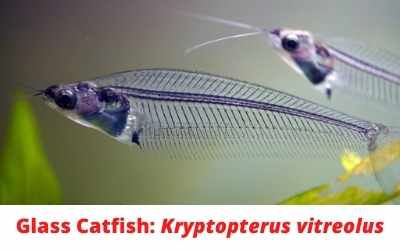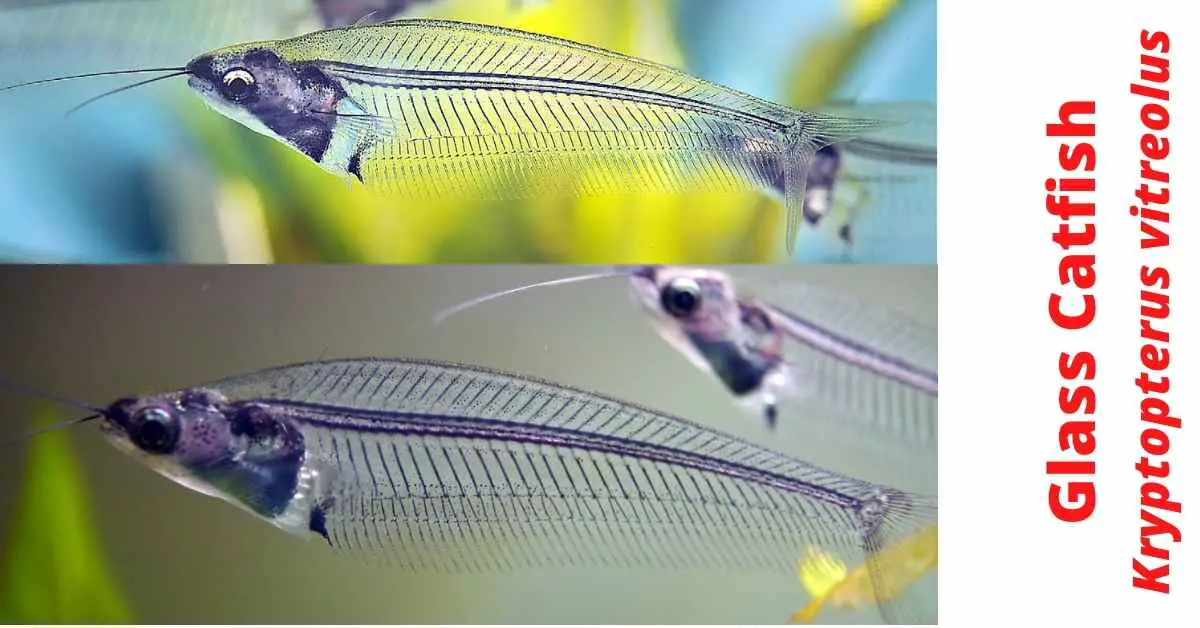Glass catfish (Kryptopterus vitreolus) is a beautiful and awesome-looking aquarium fish that is native to southeast Asia. They are typically found in the slow-flowing waters of small rivers and streams in southern Thailand and Burma. This fish is a common aquarium fish and lives in freshwater environments such as lakes, rivers, caves, and swamps. It has been kept as a pet since 1818.
Systematic Position
Phylum: Chordata
Subphylum: Vertebrata
Class: Actinopterygii (ray-finned fish)
Order: Siluriformes (catfish)
Family: Kryptopteridae
Genus: Kryptopterus
Species: Kryptopterus vitreolus
You may also read: Fish Profile: Dwarf Corydoras (Corydoras hastatus)
The glass catfish get their name from the distinctive glass-like transparency of the skin, which starts at the base of their heads and extends down to their pelvic fins. As a result, the liver and gut are easily clearly visible through their thin skin except for the eyes, the body of it is mainly transparent with only its spine catching the light and giving it a greyish appearance.
They are a very unique-looking species of fish. It is one of the smallest catfish that grow to an average length of 3 inches (8 cm) with females being larger than males. This fish tends to live either solitarily or in pairs.

The body of the fish is completely transparent with translucent gray with a pale belly, which brightens when the fish is unwell or stressed and makes it look as if they are floating with only the internal organs showing. The body is compressed with smallmouth. Their eyes are red and their fins fade with age to a darker, duller hue.
The unique, white tinted body of the glass catfish is one of the most easily recognizable traits of this fish. They have two pairs of barbels, each with a single branched ray. Their coloration varies from transparent to ‘milk white’.
They have a small, almost spherical body, which always seems to scrape the bottom of the aquarium. They have one dorsal fin that starts right behind their head. The pectoral fins are small but able to help them in swimming forward.
‘The transparent glass catfish has no scales. It can be beautiful if somewhat strange-looking addition to your aquarium. They are pretty easy to care for, but there are a few things you should be aware of before you start a glass catfish tank.
Feeding Behavior of Glass Catfish
They are self-sufficient scavengers. They will feed on dead plant and animal material that falls into their habitat. In the aquarium condition, they feed on live, frozen, or freeze-dried foods. In this case, the best food options of them are bloodworms, Artemia (Brine shrimp), Tubifex, earthworms, mosquito larvae, etc. To keep your fish happy and healthy, you should offer flake food and meaty foods.
Tank Requirements
Glass catfish are a popular aquarium fish. They have a big personality. It’s pretty easy to care for. Glass catfish are a peaceful and friendly tropical fish that make excellent additions to nano reef tanks. They prefer a tank with ample amounts of live rock or live biological materials to feed on.
It is a small-sized fish. Recommended tank requirement is 30 gallons (113.6 L) for your glass catfish. In this case, the tank should have live plants with natural hiding places which should be made with rocks and driftwoods. Floating plants make appropriate tank conditions by providing dimmer lighting. You can also use low-intensity light in your tank. For this, you should keep plants that grow in minimum lighting conditions. The following plants are the most suitable that grow in low light conditions: Anubias, Java fern, Java moss, Crypts, Amazon sword, Marimo ball, Water wisteria, Dwarf Rotala, Dwarf Sagittaria, etc.The tank should also have suitable temperatures that should be ranged from between 70 to 79°F (21 – 26°C) with a pH of 6.5-7.0 and water hardness of 8-12 KH.
Quick Glass Catfish Facts
Common name: Glass catfish, Ghost Catfish, Glass Cat, etc
Scientific name: Kryptopterus vitreolus
Temperament: Peaceful
Adult size: 2.5 – 3″ (8 cm)
Diet: Omnivore
Minimum tank Size: 30 gallons
Tank Region: Mid-layer of tank
Temperature: 70 to 79°F (21 – 26°C)
Hardness: 8-12 dGH
Water pH: 6.5-7.0
Water flow: Moderate
Care level: Moderate
Lifespan: 7-8 years
Tankmates
If kept in a group, glass cats will get along with a wide array of tank mates that include anabantoids, dwarf cichlids, apistos, rasboras, and loaches. Peaceful bottom dwellers like smaller Plecostomus (plecos) and larger species of nerite snails are also great companions for this “glass” catfish. In this case, any predator or aggressive fish should not be kept them. You may keep the following compatible tankmates with your glass catfish:
Molly;
Cory Catfish
Panda Cory
Kuhli Loach
Swordtails
Rummy Nose Tetra
Neon Tetra
Celestial Pearl Danios
Dwarf Gourami
It is recommended that the following fish species should be avoided as a tank mates for your glass catfish:
Oscars
Tiger Barbs
Sharks
Cichlids
Arowanas
Breeding Glass catfish
In the wild condition, the glass catfish can breed easily but in captive conditions, it is difficult to make them breed. During the monsoon period, the glass catfish spawn at a temperature of 75-80° F (23.9-26.7° C). They lay eggs on the plant’s body. During the breeding period, the brood fish should be fed high-quality foods. The eggs hatch within 3-4 days and the fry will become free-swimming. The fry should be fed with baby artemia (brine shrimp) and worms.
Conclusion
The Glass catfish (Kryptopterus vitreolus) is a species of Asian glass catfish in the family Ambassidae of the order Siluriformes. This fish is also called the see-through catfish. However, this fish is known for being very hardy and healthy, making it the perfect choice for a beginner.

